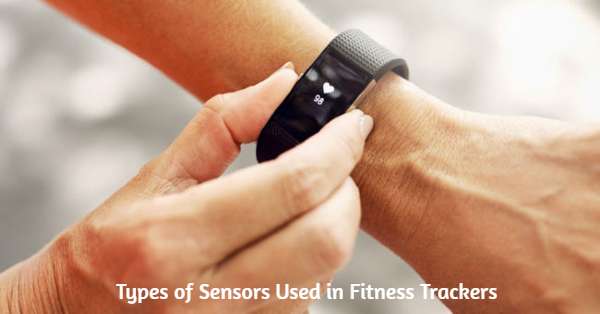In order to track the wide variety of activities of an individual, a fitness tracker makes use of various sensors.
These sensors help the fitness tracker device to measure different parameters such as duration, intensity, acceleration, sleep patterns etc…
All these parameters are put together by the algorithm to analyze the readings and the Smart band then suggest you health tips accordingly.

You can find these sensors in both the smart bands and smartwatches.
What are the Different Types of Sensors in a Fitness Tracker?
Well, there is no dearth of sensors in a smart band. The more sensors it has, the more costly it becomes.
Let us look at each type of sensor in detail now:-
1. 3-Axis Accelerometer
These sensors are common and can be found in almost all the activity trackers these days.
This is an electromechanical device that senses gravity as well as linear accelerations i.e., it tracks movements in which direction you’re moving and also take inertial measurements of your body’s position and velocity.
2. Altimeter
This sensor uses atmospheric pressure to sense any changes in the altitude. A very beneficial sensor to accurately track your steps, especially while climbing the stairs.
3. Ambient Light Sensor
How does your fitness band knew that it is night or you’re going into the sunlight? Well, that is where the ambient light sensor comes into place. It detects the time of the day by converting the light into a digital signal and then broadcasting it to the inside unit.
This sensor is also used in mobile devices to increase or decrease the screen brightness, thus saving your battery life.
4. Barometer
This measures and also shows the atmospheric pressure, thus you can know whether it is going to be sunny or rainy day.
5. Bioimpedance Sensor
These sensors are most commonly used in Smart weighing scales to measure your body composition such as the total body fat w.r.t your lean body mass.
These days some fitness trackers are also using these sensors to track heart rate, sleep patterns, hydration, respiration rate and even skin galvanization.
6. Capacitive Sensor
Do you know how some smart bands wake up from sleep when you just move your wrist? Well, the capacity proximity sensor is responsible for that feature.
It helps in lowering the power consumption by putting the device to sleep (and wake up) when not used for a long/set amount of time.
7. Compass
This sensor is mostly found in Sports Watches. It shows the direction of magnetic north and bearings from it.
8. ECG Sensor
Also known as Electrocardiogram sensor, it records the electrical impulses that are sent by your heart with each beat, through the heart muscle.
These tiny signals can only be picked up by ECG.
9. Gesture Technology
This is some future tech that controls the functionality of your devices through your body movements such as rising your hand, moving your fingers etc…
10. GPS
Global Positioning System (GPS) is one great feature in the fitness tracker that ensures your calorie burn stats are accurate.
It works by tracking your exact location while you are walking or running by calculating the distance between series of GPS satellites.
11. Gyroscope
Gyro sensor aka angular rate sensors aka angular velocity sensors help in tracking your movements more accurately while you’re on the go.
12. LTE
This is mostly seen in Smartwatches and some fitness trackers as well. A LTE enabled device, simply means that is has built-in mobile connection i.e., you can make/receive calls directly from the device itself.
13. Magnetometer
This is another useful sensor to track your coordinates exactly. The sensor measures the magnetic field of the earth and can also be used as a compass.
14. Optical Heart Rate Sensor
This is now the most popular as well as the most common feature among the fitness bands and smartwatches starting from budget variants to premium devices.
The heart rate sensor sits comfortably within the fitness tracker or smart watch, preferably under the device with a smart light against your skin.
When your heart pumps the blood, it moves through your veins at a faster pace, thereby causing less light to be reflected backwards.
The device with optical HR sensor then calculates your heart beat using a special algorithm.
However, the results are not that perfect, for you to consider them as an alternative to the heart rate monitors that are close to your chest.
15. Pulse Oximeter
Pulse oximeter sensors are in the market since 1980’s but became affordable only recently, all thanks to the advancements in healthcare technology.
It uses LEDs as a light source to emit light into the tissue and a photo detector is used to collect the light back from the skin.
They measure how well the oxygen is supplied to each part of your body from your heart.
16. Temperature Sensor
This sensor provides your body’s temperature reading or external temperature when needed.
17. UV Sensor
This is by far the most useful sensor in the list as far as I know. The UV sensor monitors the sunlight and alerts when you’re absorbing dangerous UV radiation.
Conclusion:
That’s all Friends! These are most popular sensors you normally see in any fitness tracker or smart band, depending on the price.
The fitness bands get expensive if you need built-in GPS, SpO2 monitor along with Continuous heart rate monitoring and LTE connectivity. Hope, you understood the important of sensors used in the wearable tech.
